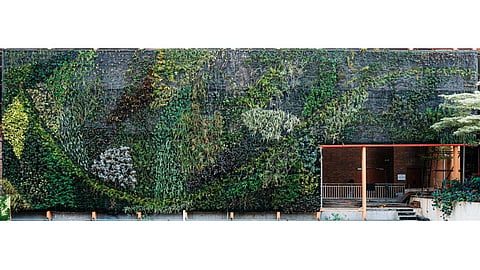
- Destinations
- Experiences
- Stay
- What's new
- Editor’s Picks
- Responsible Tourism
- CampaignsCampaigns
- Subscribe

A pioneering vertical garden that celebrates India’s wildlife heritage has been revealed at Kempegowda International Airport in Bengaluru. Titled “Tiger Wings,” the 30-foot-high and 160-foot-wide installation was designed in collaboration with Patrick Blanc, a globally recognised botanist affiliated with the French National Centre for Scientific Research.
Located at the airport’s Terminal 2 (T2), the garden is home to over 15,000 plants across 153 species, many native to Karnataka and its neighbouring regions. The feat represents Blanc’s largest project in India and exemplifies T2’s foundational philosophy of seamlessly blending nature with infrastructure.
To ensure that the wall featured species native to the region, Blanc visited several forests in the Western Ghats, where he carefully selected rare plant species from these diverse ecosystems. Utilising a soilless system with specialised felt imported from Germany, the garden’s intricate design captures the strength and elegance of India’s national animal, the tiger. Asparagus plants trace the silhouette of aeroplane wings, while vibrant red, orange, yellow and white ixora flowers represent the tiger’s signature pattern.
Hari Marar, the managing director and CEO of Bengaluru International Airport Limited (BIAL), said, “We wanted to bring in a fresh perspective to our vision of sustainability, artistry and technological advancement in a way that resonates with Bengaluru’s essence. Patrick’s innovative approach to designing living walls—allowing plants to grow as they would in nature with minimal intervention—was precisely what we envisioned for this space. Terminal 2 was anchored by four guiding principles—Terminal in a garden, technology, art and sustainability—and this wall embodies all of them. Moreover, the installation reflects our vision to harmonise nature with infrastructure, showcasing the true spirit of Bengaluru.”
The vertical garden is highly water-efficient, using a carefully designed irrigation system that delivers just the right amount of water to the plants through the felt layers. This method replicates how plants grow on natural cliff faces or rock walls, where water and nutrients are minimal, but plants thrive in crevices. Blanc’s hydroponic approach allows for a diverse array of plant species to coexist in a compact vertical space, creating a thriving ecosystem that enhances air quality and contributes to a cooler, more pleasant environment.
For Blanc, “Tiger Wings is the realisation of a dream where nature and architecture coexist seamlessly. This project transcends merely enhancing the visual landscape of the airport; it transforms the travel experience, rejuvenates the environment and preserves the rich tapestry of the natural world that surrounds us.”
The new development also marks Bengaluru becoming the first Indian city to have direct connectivity to the two largest airports in London—Heathrow and Gatwick, further reinforcing the strong economic and cultural ties between India and the United Kingdom.
Satyaki Raghunath, the CEO of BIAL, said, "We are thrilled about this new development, which strengthens our ongoing partnership with Air India and greatly enhances our connectivity to London. This new route will boost trade, tourism and cultural exchange. London is one of our busiest long-haul markets and the new service will allow our passengers have a choice of airports in London to travel to. We look forward to adding more destinations to our network, thereby reinforcing our position as the gateway to South and Central India.”
(With inputs from multiple sources)
